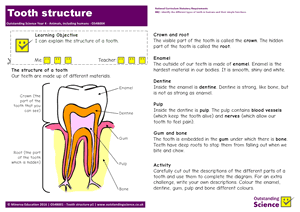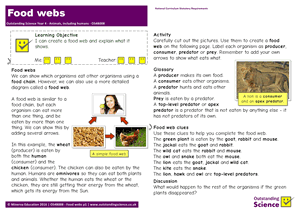

I can identify and locate the main organs of the human digestive system.
Children learn about the role of the human digestive system. They learn about the functions of the mouth, oesophagus, stomach, small intestine and large intestine. Children cut out pictures of the individual organs and paste them in place to complete a diagram, which they then label.
I can explain how the human digestive system works.
Children learn about the functions of the mouth, oesophagus, stomach, small intestine and large intestine. They use this information to complete an explanation text with accompanying diagram by either cutting and pasting text or writing their own explanation.

3 pages
I can identify the different types of human teeth and explain their functions.
Children learn that humans have 2 sets of teeth, and that teeth can be classified into different groups. They learn about the number, location and function of the incisors, canines and molars. They create a colour-coded diagram explaining the role of each type of tooth.

2 pages
I can describe the structure of a tooth.
Children learn that teeth are made up of different materials (enamel, dentine, pulp) and are embedded in the gums and skull/jawbone. Children create their own labelled diagram showing these different parts and their functions, by cutting and pasting or writing their own descriptions.

2 pages
I can explain how we can look after our teeth.
Children learn about the stages of tooth decay and how it can be caused. They learn how tooth decay can be prevented and treated. Children use a writing frame to complete an interview text, imagining themselves in the role of a dentist and explaining how we can look after our teeth.

3 pages
I can create a food chain and explain what it shows.
Children lean what a food chain is and that the arrow shows energy flow within an ecosystem. Children use the pictures provided to create food chains with 2 and 3 organisms. They identify each organism using a word bank and whether they are a predator, prey, consumer or producer.

4 pages
I can create a food web and explain what it shows.
Children learn that a food web is a way of showing the energy flow in an ecosystem in a more complex way. They create a food web containing 8 different organisms. They identify and label each organism as a consumer, producer, predator, prey, and apex predator. They add their own arrows to show energy flow through the food web.

3 pages